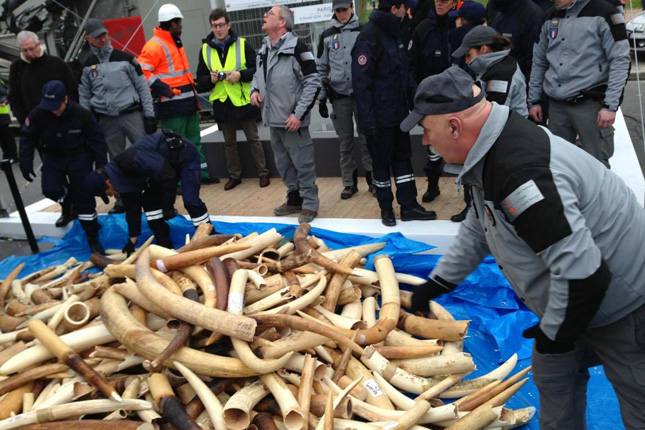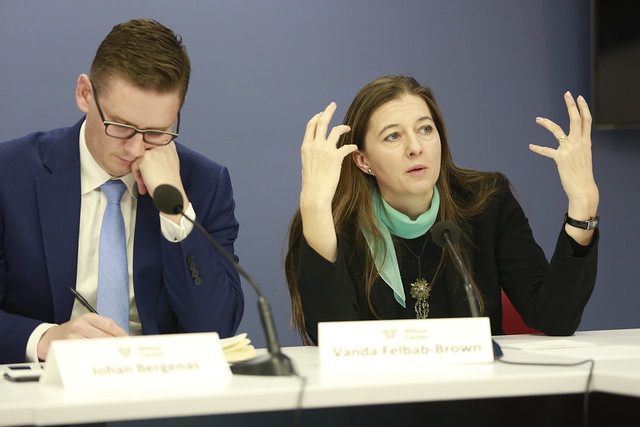-
Criminal Elements: Illegal Wildlife Trafficking, Organized Crime, and National Security
January 19, 2018 By Saiyara Khan
“The same criminals that are trafficking in drugs, guns, and people, traffic in wildlife,” said Christine Dawson, the director of the Office of Conservation and Water at the U.S. Department of State, at a recent event in the Wilson Center’s “Managing Our Planet” series. Experts from Vulcan Productions and Brookings Institution joined Dawson to discuss the links between national security and wildlife trafficking, which is now the fourth largest transnational crime in the world, and to mark recent legislative successes and innovative tools.
Why Does the U.S. Government Care about Wildlife Trafficking?
“Wildlife trafficking breeds corruption, empowers criminals, and generates tens of billions of dollars a year for transnational organized criminal networks,” said Dawson. “Wildlife trafficking can [also] be an indicator of weak state presence or governance,” that allows organized criminal networks and armed militia groups to undermine economic prosperity and “destroy the social fabric of communities, whose youth are conscripted as poachers and often paid in drugs,” she said.
The United States’ National Strategy for Combatting Wildlife Trafficking has three priorities: strengthening enforcement, reducing demand, and expanding international cooperation and commitment. In addition to the strategy, both the END Wildlife Trafficking Act—a bipartisan effort that Congress passed unanimously in 2016—and President Trump’s Executive Order on transnational crime recognize the ties between wildlife trafficking and organized criminal networks. Through these policies and in cooperation with regional wildlife enforcement networks, the U.S. government is committed to stopping the illegal trade both at home and abroad. “Governments can’t do it alone, [but] with all of our partners working together, we can stop it,” said Dawson.
What Can We Learn From the Private Sector?
When Vulcan Inc. became interested in conservation and wildlife trafficking, “We made the call that there wasn’t enough data on the actual slaughter that was going on,” said Johan Bergenas, the senior director of public policy. In 2013, Vulcan, which philanthropist and Microsoft cofounder Paul Allen launched to find new solutions to tough problems, created the Great Elephant Census.
By tracking the distribution of the elephant population in Africa, the Great Elephant Census discovered that the number of Savannah elephants had decreased by 30 percent over seven years. “The more data that you get in any given park, or on a continent, or a country, you start to see a pattern,” that enables smarter, and more strategic responses, he said. The Domain Awareness System (DAS), a data software platform designed by Vulcan Inc., integrates real-time data sources and tools, including radios, surveillance cameras, and GIS.
“The U.S. government is investing heavily in artificial intelligence, cloud computing, and all of those tools that have traditionally belonged in the defense world” to combat wildlife trafficking, said Bergenas, but they still don’t have “enough financial and other resources to actually mount a resourceful and robust response.” Technological innovations and investments from the private sector keep the momentum moving, he said.
But “there is another way to innovate, and that is to find new value for things that already exist,” said Bergenas. Integration is key: Vulcan makes it a point to work with others, in a time when there is “a lot of technological innovation [but] not as much technological integration,” he said. To design efforts that will have impact, governments and NGOs should learn another lesson from the private sector: “You [need to] listen to the customer or the partner who you want to create value for,” he said.
What Have We Learned From Fighting the Drug Trade?
“We don’t know what works, nor do we know what does not work” when it comes to combatting wildlife trafficking, said Vanda Felbab-Brown, a senior fellow at the Brookings Institution and author of the new book, The Extinction Market: Wildlife Trafficking and How to Counter It. “Illicit markets are not static,” she said. “They always adapt and evolve in response to enforcement.”
As long as there is demand for illegal wildlife products, applying traditional counter-narcotic approaches to wildlife trafficking will not work, said Felbab-Brown. Interdiction and seizures are especially counterproductive, and can even increase poaching. “All traffickers around the world assume that they will lose a portion…of their cargo to law enforcement,” she said. “They will make the assumption ‘we will lose 30-40 percent of ivory to law enforcement, hence, we are going to [order]…40 percent more elephants to be killed.”
And it’s not just organized criminals or militant groups: Members of local communities turn to the illegal trade to alleviate their poor socioeconomic conditions. “Local communities are often willing participants; they are not just bystanders or victims,” said Felbab-Brown. “For enforcement to be effective, it needs to be internalized, and have local buy-in,” as well as generate alternative livelihoods for the communities involved, she said.
When interdiction efforts were launched to prevent the smuggling of endangered birds from islands in Indonesia, the traffickers “paid the poachers—very desperately poor, local people—a pack of cigarettes for each bird caught,” said Felbab-Brown. “This is how cheap poaching is.” The poachers stuffed the captured birds into plastic bottles and threw them into the ocean with GPS trackers so they could be fished out later, and up to 95 percent of the birds died in the process. “But it didn’t matter, because they would still make profit off the five birds that would survive the absolute horrific smuggling method,” she said.
“Unlike with drugs, the rarer the product, the greater the profits in wildlife,” said Felbab-Brown, because the price goes up as the number of the animals decreases. Wildlife, also unlike most drugs, are not endlessly producible, and once extinct, can’t be reproduced. “It is often a matter of years before a species or an ecosystem is lost,” said Felbab-Brown. “Time matters.”
Ending wildlife trafficking requires not only dismantling retail markets for illicit goods, but also generating alternative livelihoods for local communities and addressing the underlying demand drivers. The solution may be to set up health clinics and increase access to medical professionals in areas where there is demand for traditional Chinese medicine, or to find food substitutes in areas in Africa where illegal bush meat is consumed for protein rather than as a prestige good. “We need to get far more creative and experimental” in finding solutions to the problem, said Felbab-Brown.
“Everyone can and should do their part to end this pernicious trade,” said Dawson, citing three principles to follow: “inform, involve, and initiate.”
Event Resources:
Sources: BBC News, Brookings, Convention on International Trade in Endangered Species of Wild Fauna and Flora, Earth Touch News Network, Great Elephant Census, The Guardian, International Conservation Caucus Foundation, National Geographic, Time, United Nations Office on Drugs and Crime, Vulcan, White House
Photo Credits: Destruction of more than 3 tons of ivory seized by French Customs over a period of 20 years, February 2014, courtesy of the International Fund for Animal Welfare
 A Publication of the Stimson Center.
A Publication of the Stimson Center.




